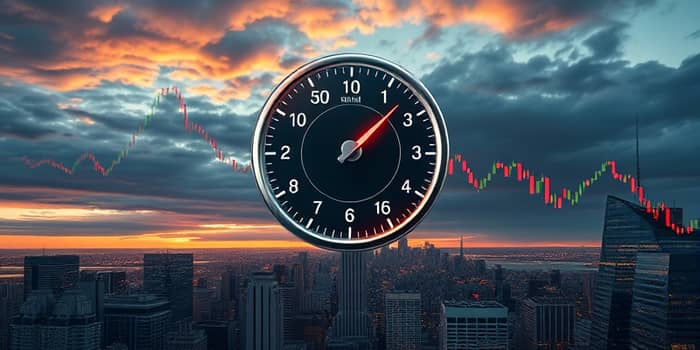
The VIX Index stands as a beacon for investors navigating uncertain times. Often called the “fear gauge,” it quantifies the collective anxiety embedded in S&P 500 options pricing. Beyond numbers, it represents a window into market psychology, offering both seasoned professionals and individual traders a compass for risk management.
In the unpredictable seas of global finance, volatility often dictates both danger and opportunity. The VIX acts as a lighthouse, guiding investors through waves of uncertainty. Whether you are a long-term saver or an active trader, studying this index can reveal when the market’s temperature is rising or cooling. By interpreting its signals, you learn to ride the waves instead of being overwhelmed by them.
The Chicago Board Options Exchange introduced the VIX in 1993 to capture annualized volatility expectations for the next 30 days. This industry-standard volatility benchmark was revamped in 2003 to base its computation on a broad array of S&P 500 options. In practical terms, the VIX aggregates the prices of calls and puts, revealing how much turbulence investors foresee.
When the VIX climbs, it signals fear and uncertainty spikes. Conversely, a declining VIX suggests market calm or rising confidence. Its inverse relationship with stocks makes it a unique tool: as equities slide, protective option demand pushes the VIX higher, and vice versa.
Much like meteorologists use barometers to forecast storms, traders use the VIX to anticipate turbulence. Its foundation in option pricing reflects the premiums buyers pay for protection, offering a quantitative measure of collective risk aversion.
Behind every VIX reading lies a rigorous mathematical process. The index pulls quotes from S&P 500 options with expirations bracketing 30 days, ensuring a consistent 30-day forward-looking view. Each option’s variance contribution is weighted, summed, and then interpolated between two expiration dates. Following this, the 30-day variance is square-rooted and annualized to yield the familiar VIX value.
This method relies on complex weighting and interpolation, rather than simplistic models. By selecting only liquid options with nonzero bid and ask prices, the VIX maintains accuracy even in extreme markets. While its calculation can seem opaque, the result is a transparent gauge of implied, not realized volatility.
Notably, the VIX computation accounts for the exact minutes to expiration, blending two expiries to maintain a consistent horizon. This precision means the index dynamically adapts as each option contract approaches maturity.
Since its inception, the VIX has chronicled the peaks and troughs of investor sentiment. It typically oscillates between 15 and 20 during placid periods. However, historic crises have sent it to extraordinary heights, painting vivid pictures of market stress.
Anecdotes from veteran traders often highlight the VIX’s uncanny timing. Those who acted on its inexplicable spikes during 2008 or 2020 found themselves better shielded from severe drawdowns, underscoring its role as more than a mere statistic.
In 2025, the VIX surged by over 158% year-to-date, underscoring renewed volatility concerns. These milestones remind us that markets can swing from complacency to chaos in a matter of days, making vigilance essential.
Knowing the VIX is only half the journey; applying it effectively completes the picture. Traders and portfolio managers leverage VIX futures and ETFs to hedge or speculate on volatility shifts. Yet, savvy investors recognize that the VIX should complement—not replace—fundamental and technical analysis.
By integrating the VIX into a broader framework, investors can empower informed market decisions and reduce the emotional toll of unpredictable moves.
Despite its power, the VIX is not a crystal ball. It measures only expected volatility derived from current option prices. It does not forecast the direction or magnitude of market moves. Moreover, the VIX is specific to the S&P 500, so it does not reflect volatility in other asset classes.
Another misconception is treating the VIX as a standalone trading signal. Combining multiple indicators and risk metrics yields a more robust strategy. Remember, periods of very low VIX can precede sharp corrections, as complacency builds unnoticed.
Additionally, extreme VIX levels can make hedging prohibitively expensive. When protection costs skyrocket, only a select few can afford to insure large portfolios, sometimes exacerbating market stress.
The VIX's role continues to evolve. New VIX-style indices now monitor volatility in bonds, commodities, and international equities, broadening the toolkit for risk management. Technological advances and alternative data sources may refine volatility forecasts, but the underlying principle remains unchanged: markets are driven by collective emotion.
Emerging trends include merging the VIX with alternative data, such as social media sentiment or machine learning models, to enhance its predictive power. As analytics evolve, the next generation of volatility indices could provide even sharper insights.
In the dance between fear and opportunity, the VIX stands as a vital partner. By decoding its signals, investors can anticipate stress points, design effective hedges, and maintain composure amidst market storms. The true power of the VIX lies not in predicting the future but in illuminating the mood of the present.
Adopt a holistic approach: blend volatility insights with fundamental research, technical analysis, and personal risk tolerance. In doing so, you transform the "fear gauge" from a source of anxiety into a tool for confident, strategic decision-making.
References













